AUDI Q5 2014 Owners Manual
Manufacturer: AUDI, Model Year: 2014, Model line: Q5, Model: AUDI Q5 2014Pages: 316, PDF Size: 78.41 MB
Page 221 of 316
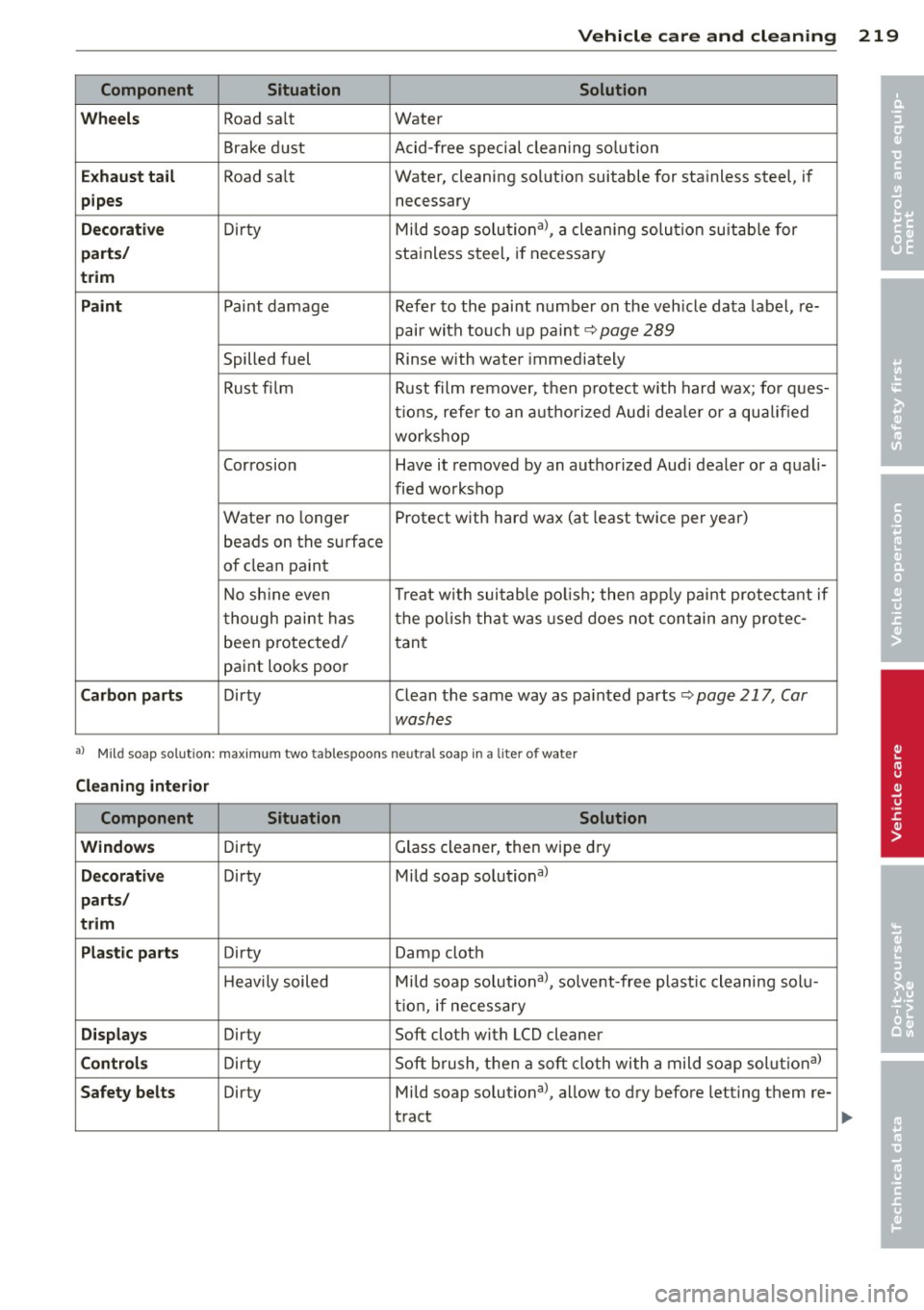
Vehicle care and cleaning 219
Component Situation Solution
Wheels
Road sa lt Water
Brake dust Acid-free special cleaning solution
Exhaust tail Road salt Water, cleaning solut ion suitable for stainless steel, if
pipes necessary
Decorative Dirty Mild soap
solutional, a cleaning solution suitab le for
parts/ stainless steel, if necessary
trim
Paint
Paint damage Refer to the paint number on the veh icle data label, re-
pair with touch up paint~
page 289
Spilled fuel R inse with water immediately
Rust fi lm Rust film1 remover, then protect with hard wax; for ques-
tions, refer to an authorized Audi dealer or a qualified
workshop
Corrosion Have it removed by an aut horized Audi dealer or a quali-
fied workshop
Water no longer Protect with hard wax (at least twice per year)
beads on th e surface
of clean paint
No shine even Treat
with suitable polish; then apply paint protectant if
though paint has the polish that was used does not contain any protec-
been protected/
tant
paint looks poor
Carbon parts Dirty Clean the same way as pa inted parts ~ page 217, Car
wash es
al Mild soap sol utio n: maximum two tablespoons neutral soap in a lite r of water
Cleaning interior
Component Situation Solution
Windows
D irty Glass
cleaner, then wipe dry
Decorative Dirty Mild soap solutional
parts/
trim
Plastic parts
Dirty Damp cloth
H eavily soiled Mild soap solutional, solvent-free plast ic cleaning solu-
tion, if neces sary
Displays Dirty Soft cloth with LCD cleaner
Controls Dirty Soft
bru5,h, then a soft cloth with a mild soap solut ional
Safety belts Dirty Mild soap solutional, allow to dry befo re letting them re-
tract
•
•
Page 222 of 316
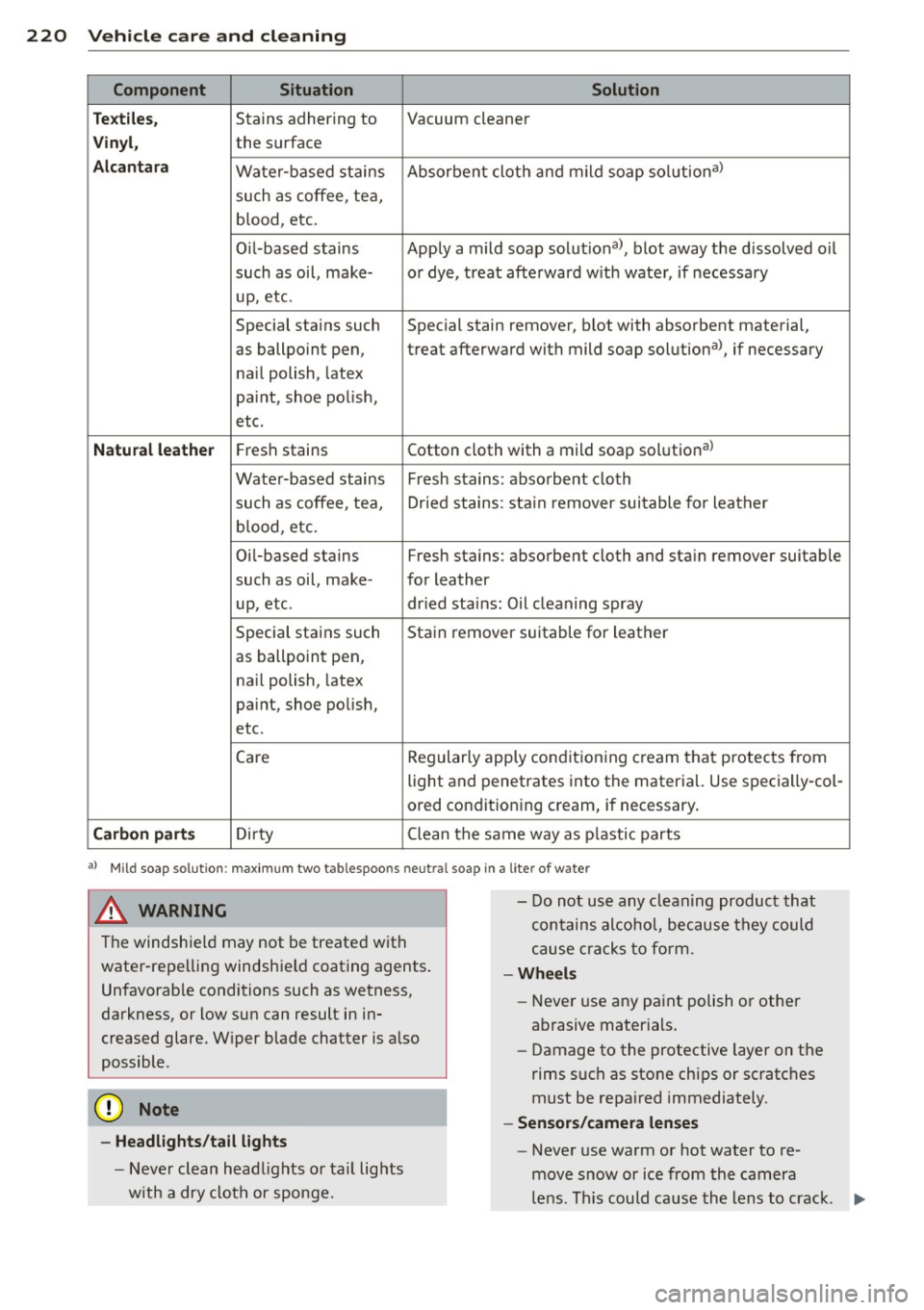
220 Vehicle care and cleaning
Component Situation Solution
T ex tile s,
Stains adhering to Vacuum cleaner
Vin yl, the surface
Alcan ta ra Water -based stains Absorbent cloth and mild soap solutiona>
such as coffee, tea,
blood, etc.
O il-based stains Apply a mild soap solutiona>, blot away the d issolved oil
such as oil, make- or dye, treat afte rward w ith water, if necessary
up, etc.
Special stains such Special stain remover, b lot with absorbent material,
as ballpoint pen, treat afterward with mild soap solutiona>, if necessary
na il polish, latex
pa int, shoe po lish,
etc.
Natu ral leather Fresh stains Cotton cloth with a mild soap solutiona>
Wate r-based stains Fresh s tains: absorbent cloth
such as coffee, tea, Dr ied stains: sta in remover sui table for leather
blood, etc.
Oi l-based stains Fresh stains: absorbent cloth and sta in remover suitable
such as oil, make- for leather
up, etc. dried stains: Oil cleaning spray
Special stains such Stain remover suitable for leather
as ballpo int pen,
na il polish, latex
pa int, shoe polish,
etc.
Care Regular
ly apply condit ion ing c ream that protec ts from
light a nd penetrates into the materia l. Use specially-col-
ored conditioning cream, if necessary.
Carbon part s Dirty Clean tlhe same way as plastic parts
a) Mi ld soap solut ion : maximum two tablespoons neut ra l soap in a lite r of wate r
& WARNING
The windshie ld may not be treated with
water -repe lling windshield coating agents .
Unfavorab le conditions such as wetness,
darkness, or low sun can result in in
creased glare. W iper blade chatter is a lso
possible .
(V Note
-Headlights /tail lights
- Never clean headlights or tail lights
w it h a dry cloth or sponge. -
Do not us e any cleaning product that
contains alcohol, because they could
cause cracks to form.
-Wheels
- Never use any paint polish or other
abrasive mater ials.
- Damage to the protective layer on the
rims such as stone chips or scratc hes
must be repa ired immediately.
- Sensor s/camera lenses
- Never use warm or hot water to re-
move snow or ice from the camera
le ns. Th is could cause th e lens to crack . ""
Page 223 of 316
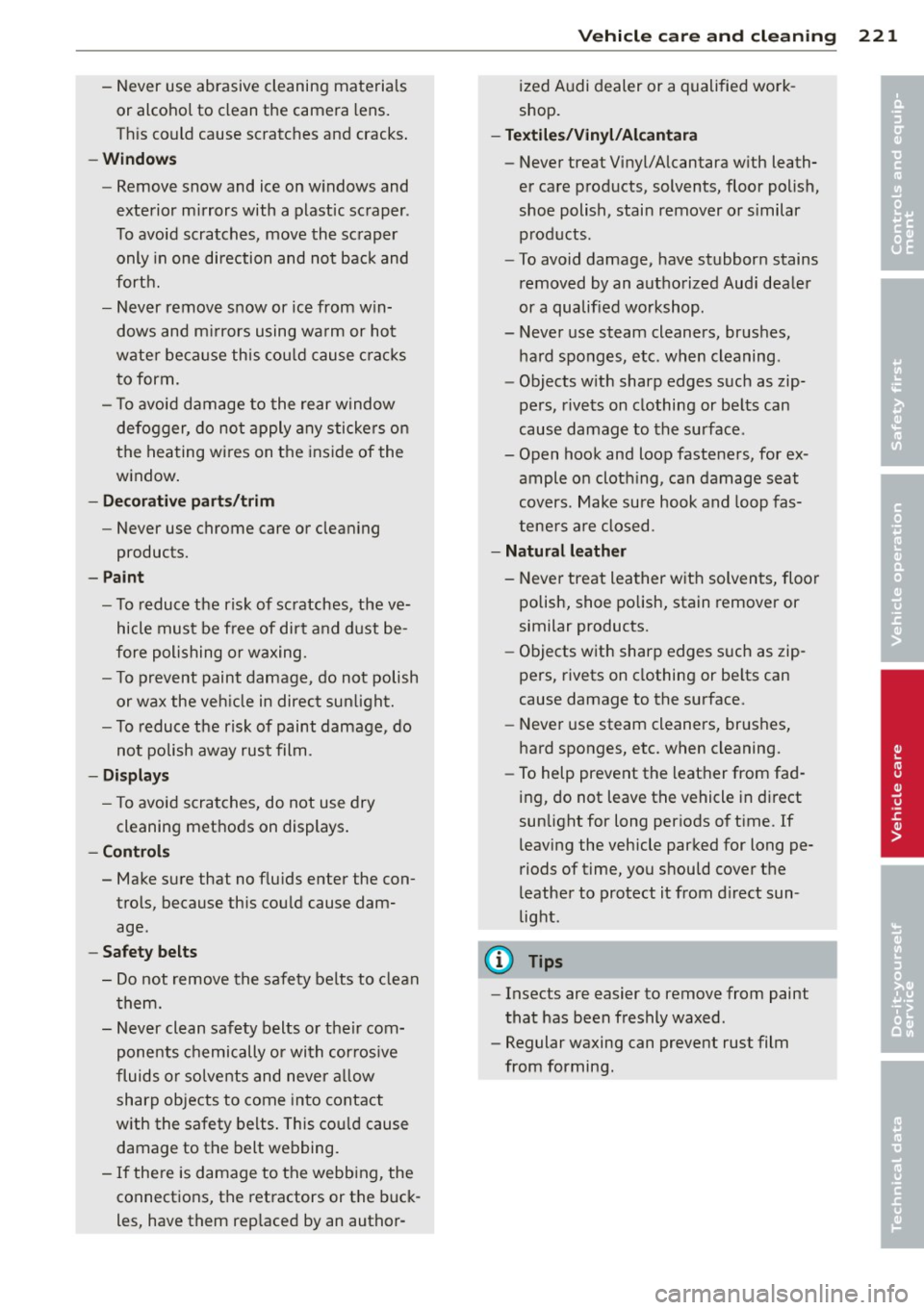
-Never use abrasive cleaning materials
or alcohol to clean the camera lens.
Th is could cause scratches and cracks .
-Window s
-Remove snow and ice on w indows and
exterior mirrors with a plastic scraper.
To avoid scratches, move the scraper only in one direction and not back and
forth.
- Never remove snow or ice from w in
dows and m irrors using wa rm or hot
wate r because this cou ld cause crac ks
to form.
- To avoid damage to the rear window
defogger, do not apply any stickers on
the heating wires on the inside of the
w indow .
-Dec or ati ve p arts /trim
-Never use chrome care or cleaning
products.
-Paint
-To reduce the risk of scratches, the ve-
hicle must be free of dirt and dust be
fore polishing or waxing.
- To prevent paint damage, do not polish
or wax the veh icle in direct sunlight.
- To reduce the risk of paint damage, do
no t polish away rust film .
-Di splay s
-To avoid scratches, do not use dry
cleaning methods on displays .
-Controls
- Make sure that no flu ids enter the con-
trols, because this cou ld cause dam
age .
-Safet y belts
- Do not remove the safety belts to clean
t hem.
- Never clean safety belts or their com
ponents chemically or with cor ros ive
fluids or solvents and never a llow
sharp objects to come into contact
with the safety belts . This cou ld cause
damage to the belt webbing.
- If the re is damage to the webb ing, the
connections, the retractors or the buck
les, have them rep laced by an author-
V ehicl e ca re a nd cl eanin g 221
ized A udi dealer or a qualified work
shop.
- Te xtile s/Vin yl/ Alcant ara
- Never treat Vinyl/Alcantara w ith leath-
er care products, solvents, floor polish,
shoe polish, stain remover or s imilar
p rod ucts.
- To avoid damage, have stubborn stains
removed by an authorized Aud i deale r
or a qualif ied workshop.
- Never use steam cleaners, brushes,
hard sponges, etc. when cleaning.
- Objects w ith sharp edges such as zip
pers, rivets on clothing or be lts can
cause damage to the surface.
- Open hook and loop fastene rs, for ex
ample on cloth ing, can damage seat
covers. Make sure hook and loop fas
tene rs a re closed.
- Natural leather
- Neve r treat leather w ith solvents, floor
polish, shoe polish, stain remover or
similar products.
- Objects with sharp edges such as zip·
pers, rivets on clothing or be lts can
cause damage to the surface.
- Never use steam cleaners, brushes,
hard sponges, etc. when cleaning.
- To help prevent the leather from fad
ing, do not leave the vehicle in d irect
sunlight for long per iods of t ime. If
leaving the vehicle parked for long pe
riods of time, you should cover the
leather to protect it from d irect sun
light.
(D Tips
- Insects are easier to remove from paint
that has been freshly waxed.
- Regular waxing can prevent rust film
from forming.
•
•
Page 224 of 316
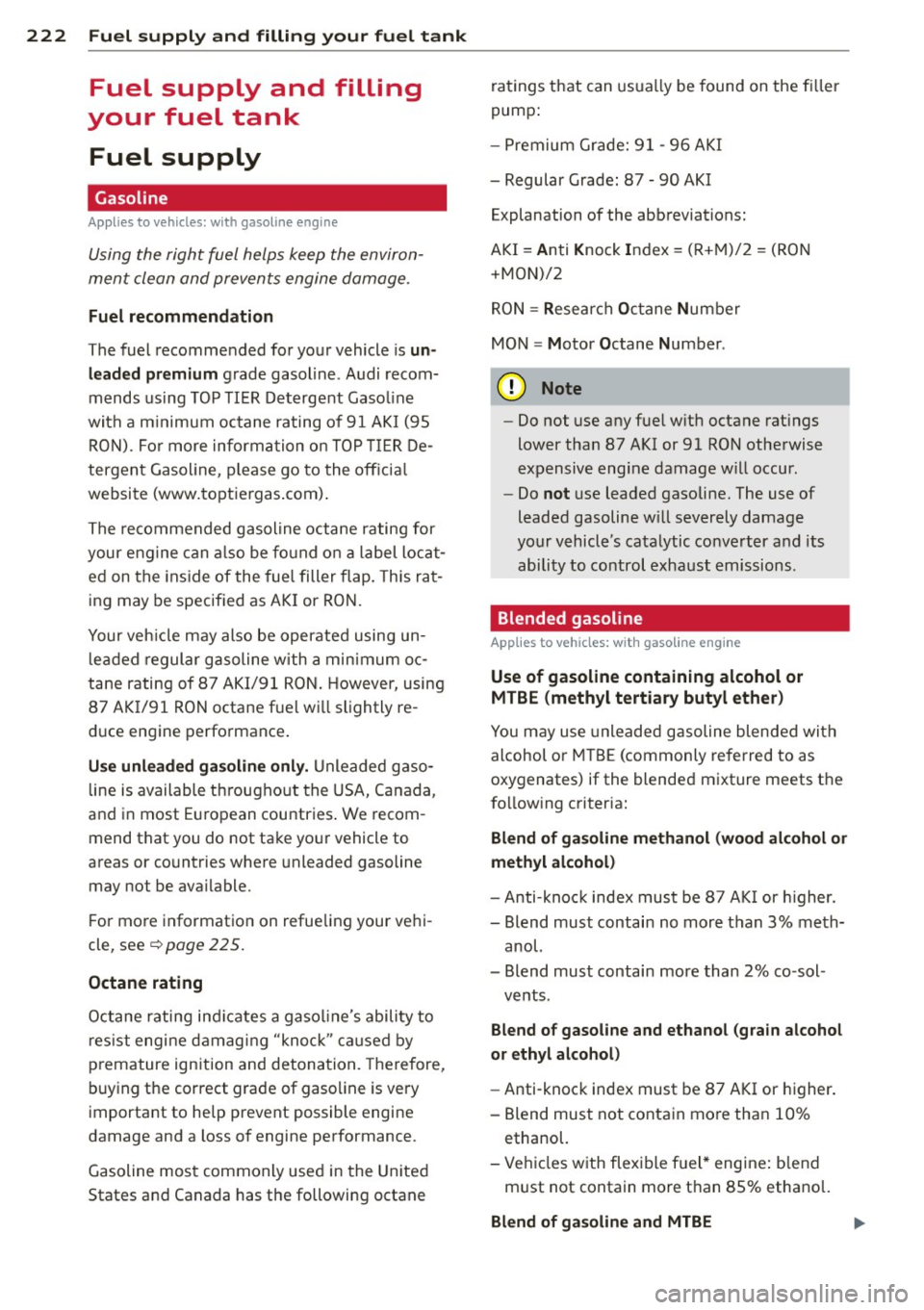
222 Fuel supply and filling your fuel tank
Fuel supply and filling
your fuel tank
Fuel supply
Gasoline
Appl ies to vehicles: with gasoline engine
Using the right fuel helps keep the environ
ment clean and prevents engine damage .
Fuel recommendation
The fuel recommended for yo ur vehicle is un
lead ed premium
grade gasolin e. Audi recom
mends us ing TO P TI ER D ete rgent Gaso line
wi th a m inimum octane ra ting of 91 A KI ( 95
RO N). For more inform ation o n TOP TIER De
tergent Gasoline, p lease go to the off icia l
websi te (www. topt iergas .com) .
T he re commended gasoline octa ne rating for
your engine can also be fo und o n a label loc at
ed on the ins ide of the fue l filler flap . This ra t
in g may be specified as AK I or RO N.
Your veh icle may also be operated u sing un
l eaded regular g asoline with a minimum oc
tane rating of 87 AKI/91 RO N. Howeve r, using
87 AKI/91 RON octa ne fue l wi ll slightly re
d uce eng ine perfo rmance .
Use unleaded ga soline only. Unleaded g aso
li ne is available th rougho ut the USA, Canada,
a nd i n most E uro pean countries . We recom
mend that you do not ta ke yo ur vehicle to
areas or countries where unleaded gasoline
may not be ava ilable.
F or mo re informat io n on refue ling your ve hi
cle, see~
page 225.
Octane rating
Octane rating ind icates a gaso line's ability to
r es ist engine dam ag in g "kno ck" cau sed b y
premature ign ition and detona tion. Therefore,
b uy ing the correct grade of gaso line is very
important to he lp prevent possible engine
damage and a loss o f engine performance.
G asoline mos t commonly used in the Unite d
States and Canada has the following octane r
atings t hat can usu a lly be found on the fi ller
pump:
- Premium Gr ade: 91 -9 6 A KI
- Regular Grade : 87 -90 AKI
Explanation of the abbreviations:
AKI = Anti Knock In d ex = (R+M) /2 = (RO N
+ MON)/2
R ON= Resea rch Octane Number
MON = Motor Octane Num ber.
(D Note
- Do not use a ny fue l w it h octane rat ings
lower tha n 87 A KI or 91 RO N othe rwise
e xpensive engine damage w ill occur.
- Do
not use leaded gasoline. The use of
leaded gasoline w ill severely damage
yo ur v ehicl e's cata lytic co nve rter a nd its
ability to co ntrol exha ust em issions .
Blended gasoline
Applies to vehicles: with gasoline engine
Use of gasoline containing alcohol or
MTBE (methyl tertiary butyl ether )
You may use unleaded g asoline blende d wi th
alcohol o r MTBE (commonly referred to as
oxygenates) if the blende d mixture meets t he
f o llow ing criteria:
Blend of gasoline methanol (wood alcohol or
methyl alcohol)
- Anti -kno ck index must be 87 A KI or higher.
- Blend must contain no more t han 3% meth-
anol.
- Blend must contain more than 2% co -sol -
vents.
Blend of gasoline and ethanol (grain alcohol
or ethyl alcohol)
- Anti -knock index must be 87 AKI or higher .
- Blend must not conta in mo re tha n 10%
ethanol.
- Ve hicl es w ith flex ible f uel * engine : blend
m ust not contain more t han 8S% ethano l.
Blend of gasoline and MTBE
Page 225 of 316

-Anti-knock index must be 87 AKI or higher.
- Blend must contain not more than 15%
MTBE.
Seasonally adjusted gasoline
Many gasoline grades are blended to perform
especially well for winter or summer driving. During seasonal change-over, we suggest that
you fill up at busy gas stat ions where the sea
sonal adjustment is more likely to be made in
time.
(D Note
- Fuels containing a high percentage of
ethanol such as ESO and E85 may only
be used in veh icles with flex ible fuel* en
gines. Using high ethano l fuel in vehicles
not equipped with flexib le fue l* engines
can cause severe engine damage .
- Methanol fuels which do not meet these
requirements may cause corrosion and
damage to plastic and rubber compo
nents in the fuel system.
- Do not use fuels that fail to meet the
specified criteria in this chapter.
- If you are unable to determine whether
or not a particular fuel blend meets the
specifications, ask your service station or
its fuel supplier.
- Do not use fuel for which the contents
cannot be identified.
- Fuel system damage and performance
problems resulting from the use of fuels
different from those specified are not
the respons ibility of Audi and are not
covered under the New Veh icle or the
Emission Control System Warranties.
- If you experience a loss of fuel economy
or driveability and performance prob
l ems due to the use of one of these fuel
blends, we recommend that you switch
to unblended fuel.
Fuel supply and filling your fuel tank 223
Ethanol fuel (Bio-ethanol)
Applies to veh icles: w it h flex ible fue l en gin e
You can recognize vehicles with a flexible fuel
engine by looking at the label on the inside of
the fuel filler flap .
Vehicles with flexible fuel engines may be op
erated with bio -ethanol fuels such as E85
(85% ethanol and 15% gasoline) or with un
leaded gasoline (91 AKI/ROZ 95) . T he vehicle
may also be operated with a mixture of these
fuels.
Your fuel consumption will increase when us
ing bio-ethanol fue ls due to the lower amount
of energy contained per unit volume in etha
nol.
Warming up the flexible fuel engine in
low temperatures
Due to the chemical composition of b io-etha
nol, a certain amount of fuel ends up in the
engine oil when driving short distances in ve ry
low temperatures. This fuel evaporates again
when the engine is warmed up.
D Please warm up engine.
If the driver message appears in the instru
ment cluster disp lay, drive with a warm en
gine to reduce the oil level.
(D Note
- Never fill with methanol or with a higher
percentage of b io-ethanol than 85%
(E85). A h igher percentage of bio-etha
nol in the fuel can cause damage to the
engine or to the fue l system.
- If you use only E85, it is recommended
to fill the fue l tank complete ly w ith un
leaded premium grade gaso line every
5,000 miles.
- If you experience starting, rough id le or
hesitation driveability problems, fill the
fuel tank comp letely with unleaded pre
mium grade gasoline and dr ive it nor
mally until the gasoline is used. See your
authorized Audi dealer if the problem
pers ists.
•
•
Page 226 of 316
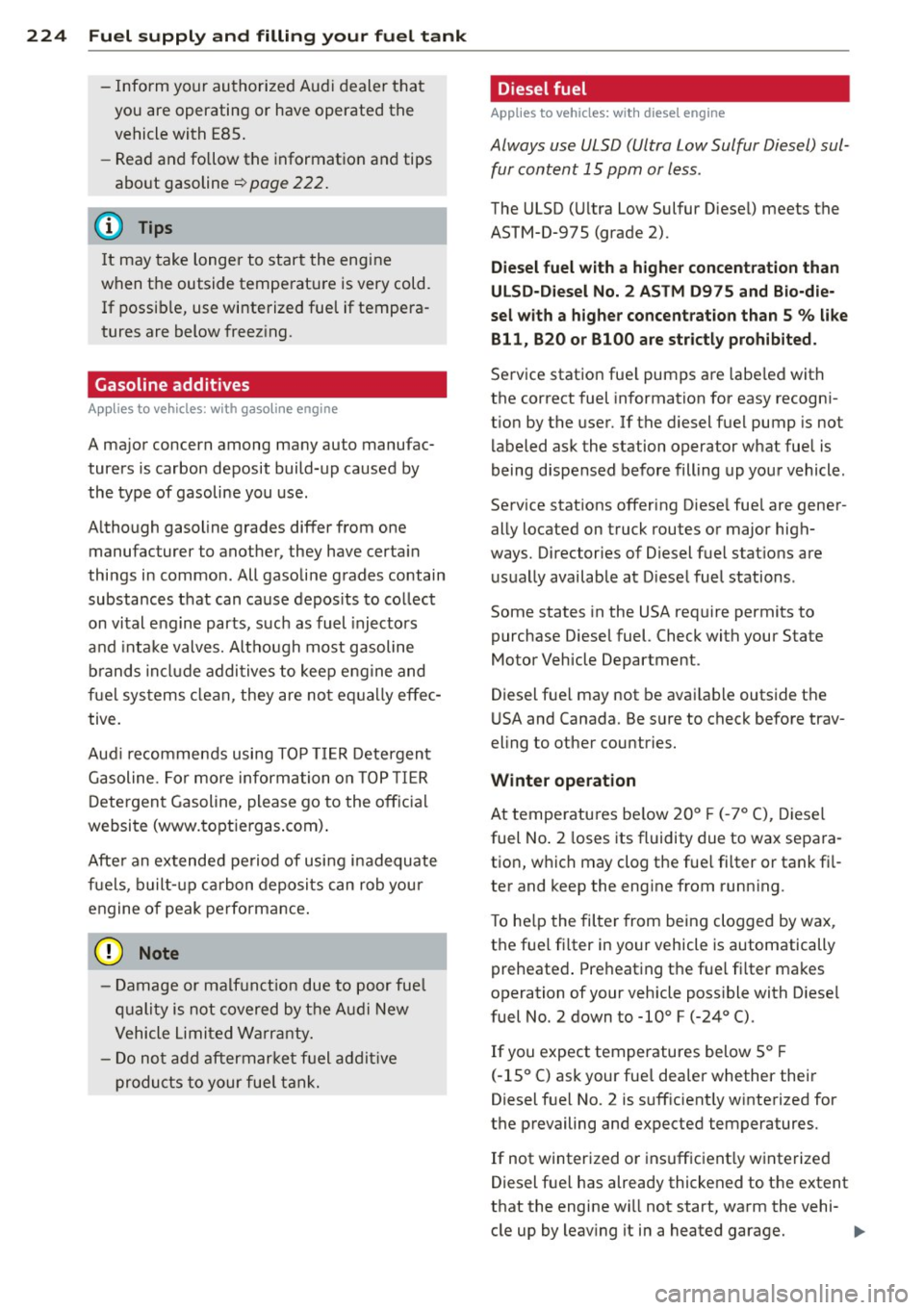
224 Fuel supply and filling your fuel tank
-Inform yo ur au tho riz ed A udi d ealer t hat
you are operating or have operated the
vehicle with E85 .
- Rea d and follow t he informat ion a nd tips
abo ut gasoline
¢ page 222 .
@ Tips
It may take longer to star t the engi ne
w hen t he outside tempe rat ure is very cold.
I f p ossi ble, use wi nterized fue l if tempera
tures are below freez ing.
Gasoline additives
App lies to vehicles: with gasoline engine
A major concern among many auto manufac
turers is carbon deposit build-up caused by
the type of gasoline you use.
A lthough gasoline grades differ from one
manufacturer to another , they have certa in
things in common. All gasoli ne g rades contain
substances that can ca use depos its to co llec t
on vi tal engine parts, suc h as fu el injectors
and inta ke valves . Although most gasoline
b rands include addi tive s to kee p eng ine and
f u e l sys tems clean, they are no t eq ually e ffec
tive.
Au di r eco mmends using TOP TIER Dete rgen t
Ga soline. Fo r more inform ation o n TOP TI ER
D etergen t Gasoline, please go to the off icial
websi te (www. to ptie rgas .com) .
Afte r an ex tended pe riod of usi ng i nadequate
f u els, b uilt-up car bon deposi ts can ro b you r
engine o f peak perform ance .
(D Note
-Damage or malf uncti on due to poor fue l
qu ality i s n ot c overed by the A udi
New
Vehicle Limi ted War ranty .
- Do n ot ad d a fter ma rk e t fu el addit ive
p rodu cts to your fue l tank.
Diesel fuel
Applies to vehicles: wit h diese l eng ine
Always use ULSD (Ultra Low Sulfur Diesel) sul
fur content 15 ppm or less .
The ULSD (Ultra Low Sulfur Diese l) meets the
ASTM-D-97S (grade 2).
Die sel fuel with a higher con cent ration than
ULSD-Diesel No. 2 ASTM D9 75 and Bio-die
sel with a higher concentrat ion than 5
% like
Bl 1, B20 or B100 are strictly prohib ited.
Se rv ice stat ion fue l pum ps a re labe led with
the correct fuel information for easy recogn i
t ion by t he user. If the d iesel fuel pump is not
l abeled ask the station operator what fuel is
being dispensed before filling up you r vehicle.
Se rv ice stat ions offering Diese l fue l are gener
ally located on t ruck routes or major high
ways. Directories of Diesel f uel stat io ns are
u sua lly available at D iese l fuel stations .
Some states in the USA req uire permits to
purchase Diesel fuel. Check with your State
Motor Vehicle Department .
Diesel f uel may not be ava ila bl e outside t he
U SA and Canada. Be s ure to check before trav
eling to other countries.
Winter operation
At tempe ratu res be low 20° F (- 7° C), Diesel
fuel No. 2 loses its fluidity due to wax sepa ra
t ion, w hich may clog the fue l fi lter or tank fi l
ter and keep the eng ine from runn ing .
T o he lp the filte r from bei ng clogged by wax,
t h e f ue l fi lter in yo ur vehicle is automatically
preheate d. Pre heat ing t he f uel fi lter makes
operation of your vehicle poss ible with D iese l
fuel No. 2 down to -10° F (-24° C) .
If you expect temperatures below 5° F
( - 15° C) ask your fue l dea ler whether thei r
Diesel f uel N o. 2 is s uff icient ly w interized for
the prevailing and expected temperatures.
If not winter ized o r ins uff ic ient ly w interized
Diesel f uel has already thickened to t he extent
t h at the engine wi ll not start, warm the vehi -
cle up by leav ing it in a heated garage.
II>
Page 227 of 316
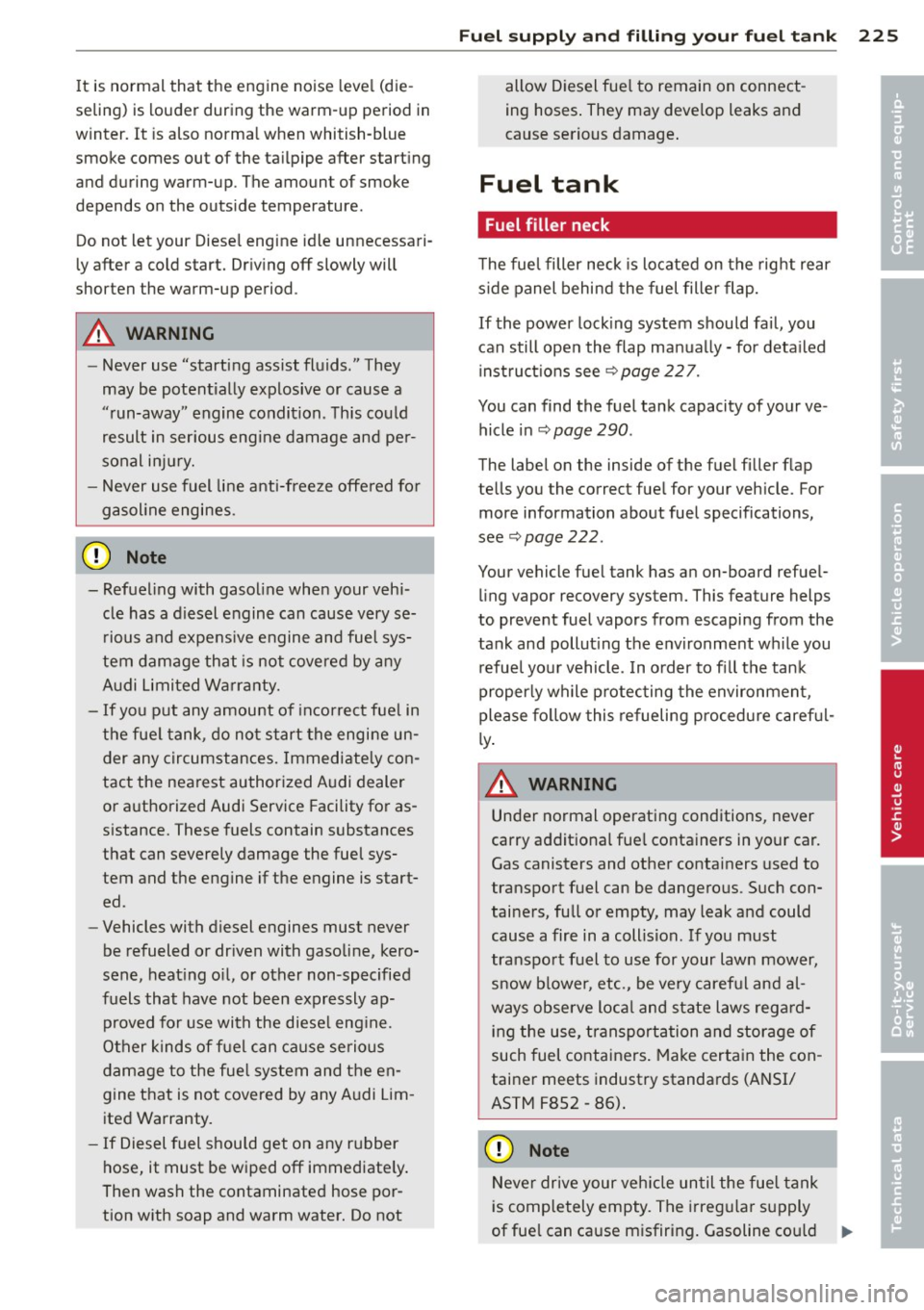
It is normal that the engine noise leve l (die
seling) is louder during the warm-up period in
winter.
It i s also norma l when whitish-blue
smoke comes out of the tailpipe after starting
and during warm-up . The amount of smoke
depends on the outside temperature.
Do not let your Diese l engine id le unnecessari
ly after a cold start. Driving off slowly will
shorten the warm-up period .
A WARNING
-Never use "starting assist fluids ." They
may be potent ially explosive or cause a
"run-away" engine condition. This cou ld
result in serious engine damage and per
sonal injury.
- Never use fuel line anti-freeze offered for
gasoline engines .
(D Note
- Refueling with gasoline when your vehi
cle has a d iesel engine can cause very se
rious and expens ive engine and fuel sys
tem damage that is not covered by any
A udi Limited Warranty.
- If you put any amount of incorrect fue l in
the fue l tank, do not start the engine un
der any circumstances. Immediately con
tact the nearest authorized Audi dealer
or authorized Audi Service Facility for as
sistance. These fuels contain substances
that can severely damage the fuel sys
tem and the engine if the engine is start
ed .
- Vehicles with diesel engines must never
be refueled or dr iven with gasoline, kero
sene, heat ing o il, or other non-specified
fuels that have not been expressly ap proved for use with the diese l eng ine.
Other kinds of fuel can cause se rious
damage to the fue l system and the en
gine that is not covered by any Audi Lim
ited Warranty.
- If Diesel fuel shou ld get on any rubber
hose, it must be wiped off immediate ly.
Then wash the contaminated hose por
tion with soap and warm water. Do not
-
Fu el su ppl y and fi lling yo ur fu el t an k 225
allow Diesel fue l to remain on connect
ing hoses . They may deve lop leaks and
cause serious damage .
Fuel tank
Fuel filler neck
The fue l filler neck is located on the right rear
s ide panel behind the fuel filler flap.
If the power lock ing system should fa il, you
can still open the flap manually - for detailed
instruct ions see
¢ page 22 7.
You can find the fuel tank capacity of your ve
hicle in
~ page 290 .
The label on the inside of the fuel filler flap
tells you the correc t fuel for your vehicle. For
more information about fuel specifications,
see ~
page 222.
Your vehicle fue l tank has an on-board refuel
ling vapor recovery system. This feature helps
to prevent fuel vapors from escaping from the
tank and pollut ing the environment wh ile you
refue l your vehicle . In order to fi ll the tank
properly while protecting the environmen t,
please fo llow this refueling p rocedure caref ul
ly .
A WARNING
-
Under normal operating conditions, never
carry additional fue l containers in your car.
Gas canisters and other containers used to
transport fuel can be dangerous. Such con
tainers, full or empty, may leak and could
cause a fire in a collision. If you must
transport fuel to use for your lawn mower,
snow blower, etc., be very careful and al
ways observe loca l and state laws regard
ing the use, transportation and storage of
such fuel containers. Make certain the con
tainer meets industry standards (ANSI/
ASTM F852 - 86).
{[) Note
Never drive your veh icle until the fuel tank
is completely empty. The irregu lar supply
of fue l can cause misfiring. Gasoline cou ld
ll-
•
•
Page 228 of 316
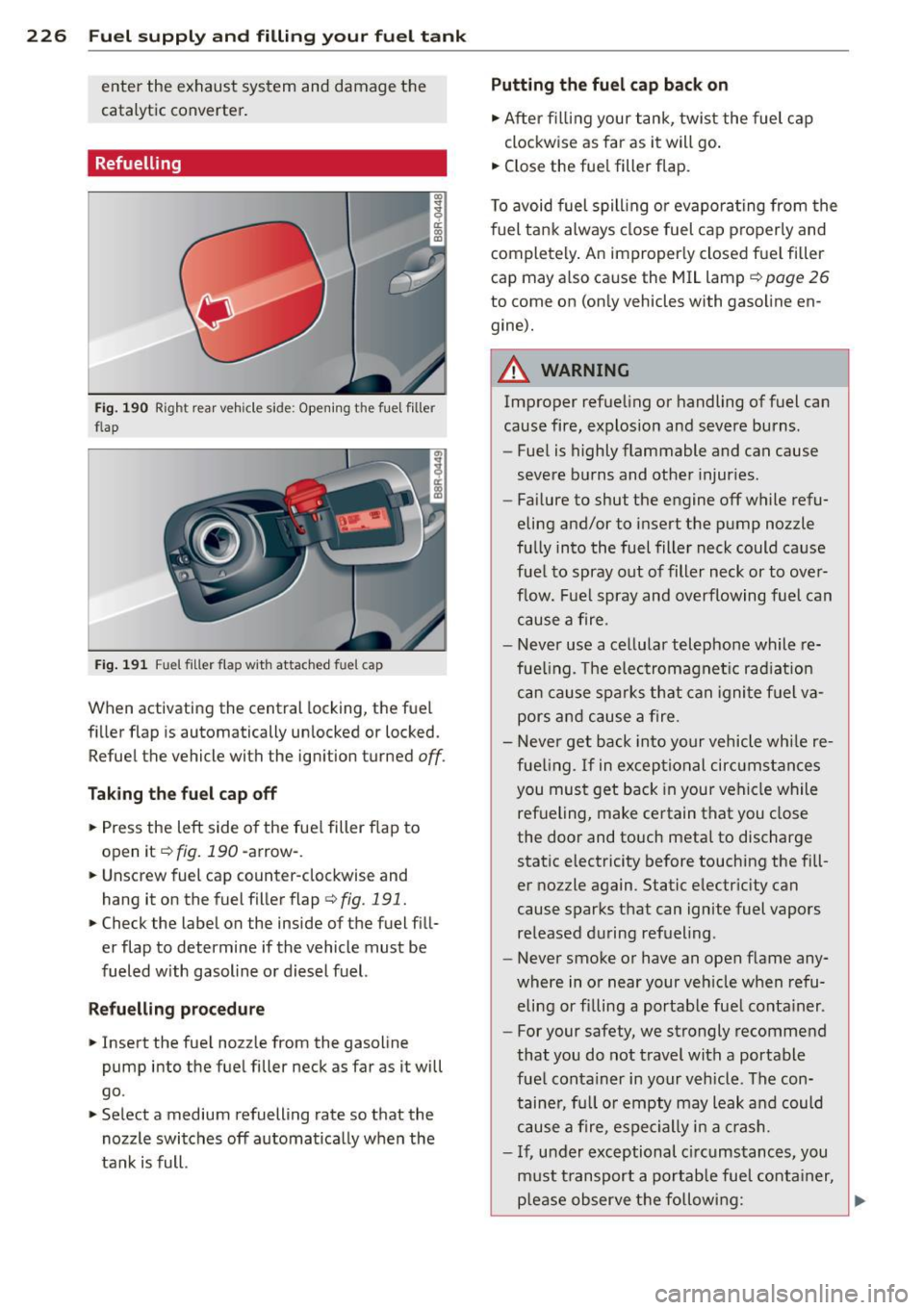
226 Fuel suppl y and filli ng your fu el t ank
enter the exhaust system and damage the
catalytic converter.
Refuelling
Fig. 190 Righ t rear ve hicle si de: Opening t he fuel filler
fl ap
Fig . 191 Fu el filler fla p w ith attached fuel cap
When activating the central locking, the fuel
filler flap is automatically unlocked or locked.
Refuel the vehicle with the ign ition turned
off .
Tak ing th e fu el cap off
• Press the Left side of the fue l filler flap to
open it ¢
fig. 190 -arrow-.
.. Unscrew fuel cap counter-clockwise and
hang it on the fuel filler flap ¢
fig. 191.
.. Check the Label on the inside of the fuel fill
er flap to determine if the vehicle must be
fueled with gasoline or diesel fuel.
Ref uelling pr ocedu re
.. Insert the fue l no zzle from the gasoline
pump into the fuel filler neck as far as it will
go .
.. Select a medium refuelling rate so that the
nozzle switches off automatically when the
tan k is full .
Putting the fu el cap b ack o n
• After f illing your tank, twist the fuel cap
clockwise as far as it will go .
.. Close the fue l filler flap.
T o avoid fuel spill ing o r evaporating from the
fuel tank always close fuel cap p roperly and
completely . An improperly closed fuel filler
cap may a lso ca use the
MIL Lamp ¢ page 26
to come on (on ly vehicles with gasoline en
gine).
A WARNING
-Improper refueling or handling of fuel can
cause fire, explosion and severe burns .
- Fuel is highly flammable and can cause
severe bu rns and other injur ies.
- Failure to shut the engine off while refu
eling and/or to insert the pump nozzle
fully into the fuel filler neck could cause
fuel to spray out of filler neck or to over
flow. Fue l spray and overflowing fuel can
cause a fire .
- Never use a cellular telephone while re
fue ling. The electromagnet ic rad iat ion
can cause spa rks that can ignite f uel va
pors and cause a fire .
- Never get back into your vehicle whi le re
fue ling.
If in exceptional circ umstances
you must get back in your vehicle while
refueling, make certain that you close
the door and touch metal to discharge
static e lectricity before touching the fill
er nozzle again . Static e lectr icity can
cause sparks that can ignite fuel vapors
released du ring refueling .
- Never smoke or have an open flame any
where in or near your vehicle when refu eling or filling a portable fuel conta iner.
- For your safety, we strongly recommend
that you do not travel with a portable
fuel conta iner in your vehicle . The con
tainer, fu ll o r empty may leak and could
cause a fire, especially i n a c rash.
- If , under exceptional c ircumstances, you
must transport a portab le fuel conta iner,
p lease observe the following: .,.
Page 229 of 316
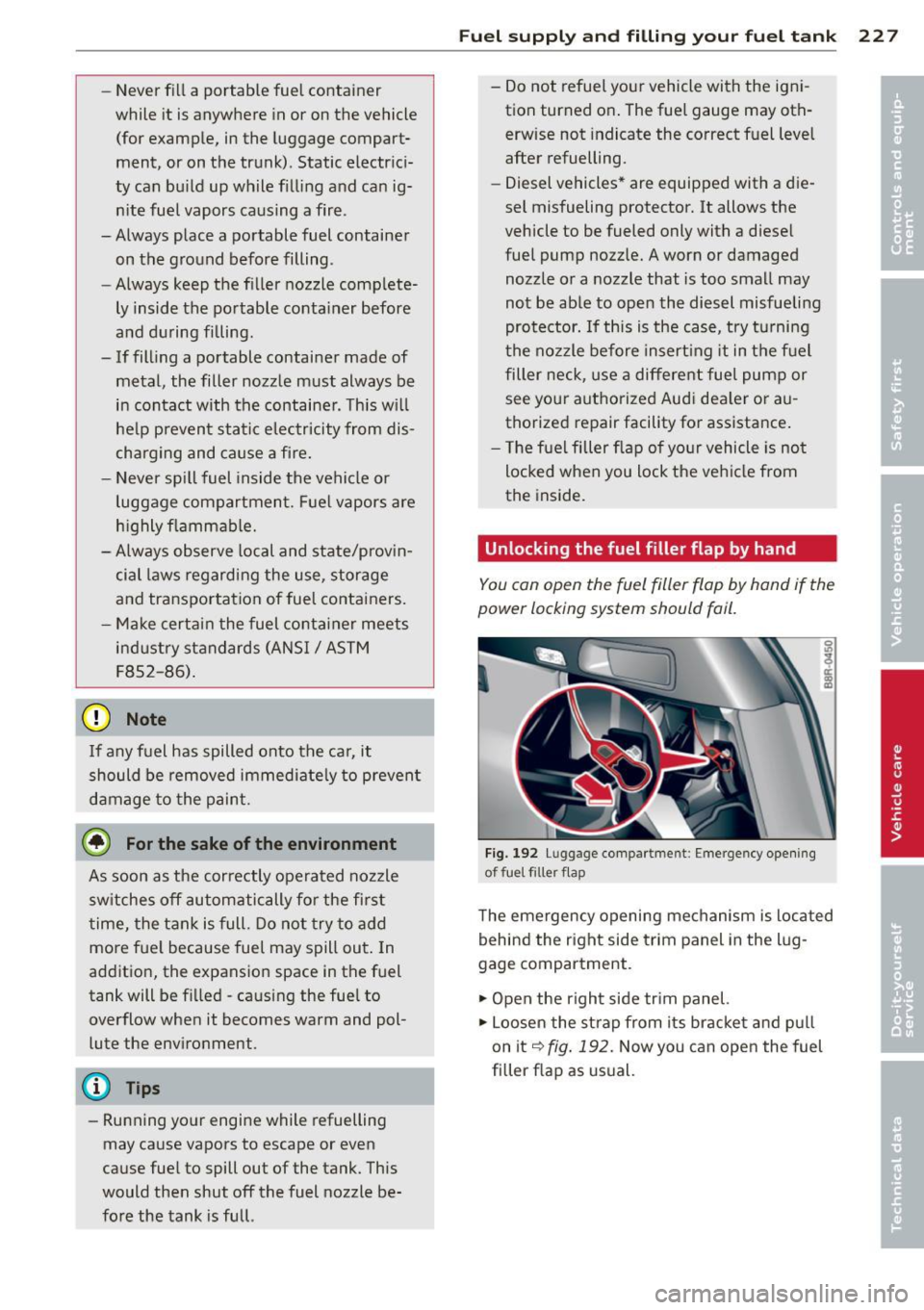
-Never f ill a portable fuel container
while it is anywhere in or on the vehicle
(for example, in the luggage compart
ment, or on the trunk). Static electrici
ty can bu ild up while filling and can ig
nite fuel vapors causing a fire .
- Always place a portable fuel container on the ground before filling.
- Always keep the filler nozzle complete
ly inside the portable container before
and during filling.
- If fill ing a portable container made of
metal, the filler nozzle must always be
in contact with the container. This will
help prevent static electricity from dis
charging and cause a fire.
- Never spill fuel inside the vehicle or
luggage compartment. Fuel vapors are
h ig hly flammable.
- Always observe local and state/provin
cial laws regarding the use, storage
and transportation of fuel containers.
- Make certain the fuel container meets
industry standards (ANSI/ ASTM
F852-86).
(D Note
If any fuel has spilled onto the car, it
should be removed immediate ly to prevent
damage to the paint.
@ For the sake of the environment
As soon as the correctly operated nozzle
switches off automatically for the first
time, the tank is full. Do not try to add
more fue l because fuel may spill out. In
addition, the expansion space in the fuel
tank will be fi lled -causing the fue l to
overflow when it becomes warm and pol
lute the environment.
@ Tips
-Running your engine while refuelling
may cause vapors to escape or even
cause fuel to spill out of the tank. This
would then shut off the fuel nozzle be
fore the tank is full.
Fuel su ppl y and filling your fuel ta nk 22 7
-Do not refuel your vehicle with the igni
tion turned on . The fuel gauge may oth
erwise not indicate the correct fuel level
after refuelling.
- Diesel vehicles* are equipped with a die
sel misfueling protector. It allows the
vehicle to be fueled only with a diesel
fuel pump nozzle. A worn or damaged nozzle or a nozzle that is too small may
not be able to open the diesel misfueling
protector. If this is the case, try tu rning
the nozzle before insert ing it in the fuel
filler neck, use a different fuel pump or
see your authorized Audi dea ler
or au
thorized repair facility for assistance.
- The fuel filler flap of your vehicle is not
locked when you lock the vehicle from
the inside.
Unlocking the fuel filler flap by hand
You can open the fuel filler flap by hand if the
power locking system should fail.
Fig. 192 Luggage compartme nt: Eme rge ncy opening
of fuel filler f lap
The emergency opening mechanism is located
behind the right side trim panel in the lug
gage compartment.
.,. Open the r ight side trim panel.
• Loosen the st rap from its bracket and pull
on it¢
fig. 192. Now you can open the fuel
filler flap as usual.
Page 230 of 316
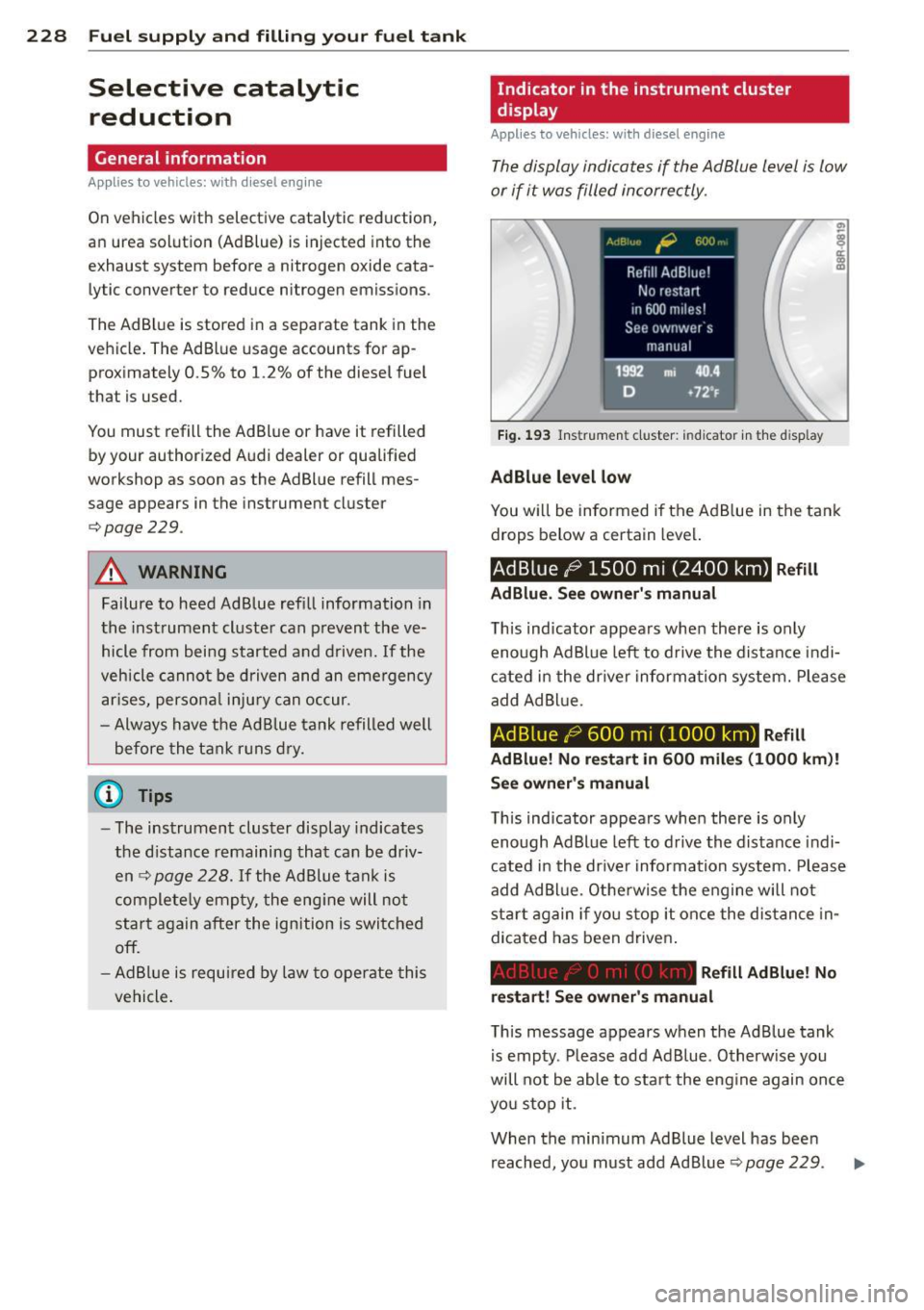
228 Fuel supply and filling your fuel tank
Selective catalytic
reduction
General information
Applies to vehicles: wit h diese l en gi ne
On vehicles with selective catalytic reduction,
an urea solution (Ad Blue) is injected into the
exhaust system before a nitrogen oxide cata
lytic converter to reduce nitrogen emissions.
The Ad Blue is stored in a separate tank in the
vehicle . The Ad Blue usage accounts for ap
proximately 0.5% to 1.2% of the diesel fuel
that is used.
You must refill the Ad Blue or have it refilled
by your authorized Audi dealer or qualified
workshop as soon as the AdBlue refill mes sage appears in the instrument cluster
c;,page229.
A WARNING
Failure to heed Ad Blue refill information in
the instrument cluster can prevent the ve
hicle from being started and driven. If the
vehicle cannot be driven and an emergency
arises, persona l inju ry can occur.
- Always have the Ad Blue tank refilled well
before the tank ru ns dry.
@ Tips
-The instrument cluster display indicates
the distance remaining that can be driv
en
c;, poge 228. If the Ad Blue tank is
completely empty, the engine will not
start again after the ignition is switched
off.
- AdBlue is required by law to operate this
vehicle.
Indicator in the instrument cluster
display
Applies to veh icles: w ith diesel en gine
The display indicates if the Ad Blue level is low
or if it was filled incorrectly.
Fig. 193 Ins trumen t cluster : in d icato r in the d isp lay
AdBlue level low
You w ill be informed if the Ad Blue in the tank
drops below a certain level.
Ad Blue l;) 1500 m i (2400 km) Refill
AdBlue. See owner's manual
This indicator appears when there is only
enough Ad Blue left to drive the distance indi
cated in the driver information system. Please
add AdBl ue.
AdBlue l;; 600 mi (1000 km) Refill
AdBlue! No restart in 600 miles (1000 km)!
See owner 's manual
This indicator appears when there is only
enough Ad Blue left to drive the distance indi
cated in the driver information system. Please
add Ad Blue. Otherwise the engine will not
sta rt again if you stop it once the distance in
dicated has been driven .
Refill Ad Blue! No
restart! See owner's manual
This message appears when the Ad Blue tank
is empty. Please add Ad Blue. Otherwise you
will not be able to start the engine again once
you stop it.
When the minimum Ad Blue level has been reached, you must add Ad Blue
c;, page 229.